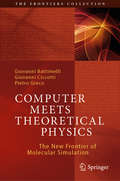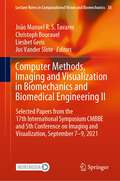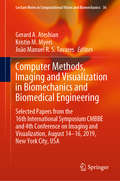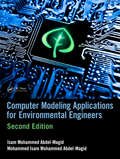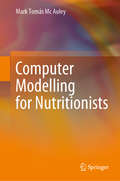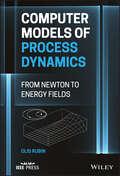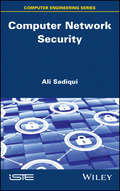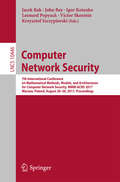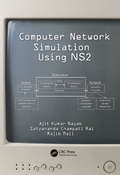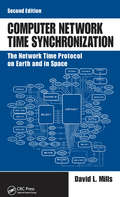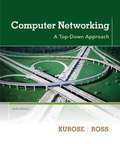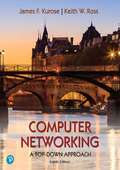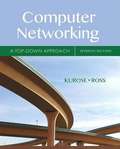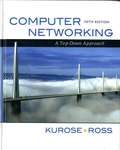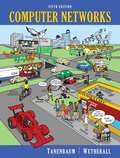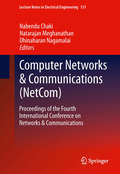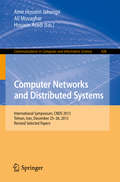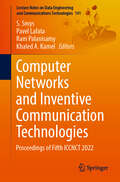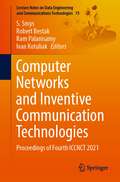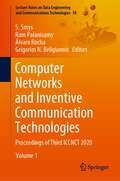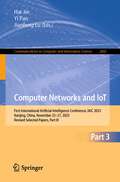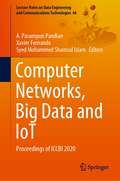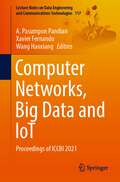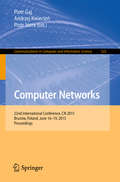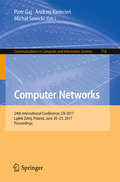- Table View
- List View
Computer Meets Theoretical Physics: The New Frontier of Molecular Simulation (The Frontiers Collection)
by Pietro Greco Giovanni Battimelli Giovanni CiccottiThis book provides a vivid account of the early history of molecular simulation, a new frontier for our understanding of matter that was opened when the demands of theoretical physicists were met by the availability of the modern computers. Since their inception, electronic computers have enormously increased their performance, thus making possible the unprecedented technological revolution that characterizes our present times. This obvious technological advancement has brought with it a silent scientific revolution in the practice of theoretical physics. In particular, in the physics of matter it has opened up a direct route from the microscopic physical laws to observable phenomena. One can now study the time evolution of systems composed of millions of molecules, and simulate the behaviour of macroscopic materials and actually predict their properties. Molecular simulation has provided a new theoretical and conceptual tool that physicists could only dream of when the foundations of statistical mechanics were laid. Molecular simulation has undergone impressive development, both in the size of the scientific community involved and in the range and scope of its applications. It has become the ubiquitous workhorse for investigating the nature of complex condensed matter systems in physics, chemistry, materials and the life sciences. Yet these developments remain largely unknown outside the inner circles of practitioners, and they have so far never been described for a wider public. The main objective of this book is therefore to offer a reasonably comprehensive reconstruction of the early history of molecular simulation addressed to an audience of both scientists and interested non-scientists, describing the scientific and personal trajectories of the main protagonists and discussing the deep conceptual innovations that their work produced.
Computer Methods, Imaging and Visualization in Biomechanics and Biomedical Engineering II: Selected Papers from the 17th International Symposium CMBBE and 5th Conference on Imaging and Visualization, September 7-9, 2021 (Lecture Notes in Computational Vision and Biomechanics #38)
by João Manuel R. S. Tavares Liesbet Geris Christoph Bourauel Jos Vander SloteThis book gathers selected, extended and revised contributions to the 17th International Symposium on Computer Methods in Biomechanics and Biomedical Engineering and the 5th Conference on Imaging and Visualization (CMBBE 2021), held online on September 7-9, 2021, from Bonn, Germany. It reports on cutting-edge models, algorithms and imaging techniques for studying cells, tissues and organs in normal and pathological conditions. It covers numerical and machine learning methods, finite element modeling and virtual reality techniques, applied to understand biomechanics of movement, fluid and soft tissue biomechanics. It also reports on related advances in rehabilitation, surgery and diagnosis. All in all, this book offers a timely snapshot of the latest research and current challenges at the interface between biomedical engineering, computational biomechanics and biological imaging. Thus, it is expected to provide a source of inspiration for future research and cross-disciplinary collaborations.
Computer Methods, Imaging and Visualization in Biomechanics and Biomedical Engineering: Selected Papers from the 16th International Symposium CMBBE and 4th Conference on Imaging and Visualization, August 14-16, 2019, New York City, USA (Lecture Notes in Computational Vision and Biomechanics #36)
by João Manuel R. S. Tavares Gerard A. Ateshian Kristin M. MyersThis book gathers selected, extended and revised contributions to the 16th International Symposium on Computer Methods in Biomechanics and Biomedical Engineering, and the 4th Conference on Imaging and Visualization (CMBBE 2019), held on August 14-16, 2019, in New York City, USA. It reports on cutting-edge models and algorithms for studying various tissues and organs in normal and pathological conditions; innovative imaging and visualization techniques; and the latest diagnostic tools. Further topics addressed include: numerical methods, machine learning approaches, FEM models, and high-resolution imaging and real-time visualization methods applied for biomedical purposes. Given the scope of its coverage, the book provides graduate students and researchers with a timely and insightful snapshot of the latest research and current challenges in biomedical engineering, computational biomechanics and biological imaging, as well as a source of inspiration for future research and cross-disciplinary collaborations.
Computer Modeling Applications for Environmental Engineers
by Isam Mohammed Abdel-Magid Ahmed Mohammed Isam Mohammed Abdel-MagidComputer Modeling Applications for Environmental Engineers in its second edition incorporates changes and introduces new concepts using Visual Basic.NET, a programming language chosen for its ease of comprehensive usage. This book offers a complete understanding of the basic principles of environmental engineering and integrates new sections that address Noise Pollution and Abatement and municipal solid-waste problem solving, financing of waste facilities, and the engineering of treatment methods that address sanitary landfill, biochemical processes, and combustion and energy recovery. Its practical approach serves to aid in the teaching of environmental engineering unit operations and processes design and demonstrates effective problem-solving practices that facilitate self-teaching. A vital reference for students and professional sanitary and environmental engineers this work also serves as a stand-alone problem-solving text with well-defined, real-work examples and explanations.
Computer Modelling for Nutritionists
by Mark Tomás Mc AuleyThis book draws on Mark Mc Auley’s wealth of experience to provide an intuitive step-by-step guide to the modelling process. It also provides case studies detailing the creation of biological process models. Mark Mc Auley has over 15 years’ experience of applying computing to challenges in bioscience. Currently he is employed as a Senior Lecturer in Chemical Engineering at the University of Chester. He has published widely on the use of computer modelling in nutrition and uses computer modelling to both enhance and enrich the learning experience of the students that he teaches. He has taught computer modelling to individuals at a wide variety of levels and from different backgrounds, from undergraduate nutrition students to PhD and medical students.
Computer Models of Process Dynamics: From Newton to Energy Fields
by Olis Harold RubinCOMPUTER MODELS OF PROCESS DYNAMICS Comprehensive overview of techniques for describing physical phenomena by means of computer models that are determined by mathematical analysis Computer Models of Process Dynamics covers everything required to do computer based mathematical modeling of dynamic systems, including an introduction to a scientific language, its use to program essential operations, and methods to approximate the integration of continuous signals. From a practical standpoint, readers will learn how to build computer models that simulate differential equations. They are also shown how to model physical objects of increasing complexity, where the most complex objects are simulated by finite element models, and how to follow a formal procedure in order to build a valid computer model. To aid in reader comprehension, a series of case studies is presented that covers myriad different topics to provide a view of the challenges that fall within this discipline. The book concludes with a discussion of how computer models are used in an engineering project where the readers would operate in a team environment. Other topics covered in Computer Models of Process Dynamics include: Computer hardware and software, covering algebraic expressions, math functions, computation loops, decision-making, graphics, and user-defined functions Creative thinking and scientific theories, covering the Ancients, the Renaissance, Galileo, Newton, electricity and magnetism, and newer sciences Uncertainty and softer science, covering random number generators, statistical analysis of data, the method of least squares, and state/velocity estimators Flight simulators, covering the motion of an aircraft, the equations of motion, short period pitching motion, and phugoid motion Established engineers and programmers, along with students and academics in related programs of study, can harness the comprehensive information in Computer Models of Process Dynamics to gain mastery over the subject and be ready to use their knowledge in many practical applications in the field.
Computer Network Security
by Ali SadiquiDeveloped in collaboration with a training and certification team from Cisco, Computer Network Security is an exploration of the state-of-the-art and good practices in setting up a secure computer system. Concrete examples are offered in each chapter, to help the reader to master the concept and apply the security configuration. This book is intended for students preparing for the CCNA Security Exam (210-260 IINS) ? whether at professional training centers, technical faculties, or training centers associated with the "Cisco Academy" program. It is also relevant to anyone interested in computer security, be they professionals in this field or users who want to identify the threats and vulnerabilities of a network to ensure better security.
Computer Network Security: 7th International Conference on Mathematical Methods, Models, and Architectures for Computer Network Security, MMM-ACNS 2017, Warsaw, Poland, August 28-30, 2017, Proceedings (Lecture Notes in Computer Science #10446)
by Krzysztof Szczypiorski Jacek Rak John Bay Igor Kotenko Leonard Popyack Victor SkorminThis book presents the refereed proceedings of the International Workshop on Mathematical Methods, Models, and Architectures for Network Security Systems, MMM-ACNS 2001, held in St. Petersburg in May 2001. The 24 revised full papers presented together with five invited contributions were carefully reviewed and selected from 36 submissions. The papers are organized in topical sections on network security systems: foundations, models and architectures; intrusion detection: foundations and models; access control, authentication, and authorization; and cryptography and steganography: mathematical basis, protocols, and applied methods.
Computer Network Simulation Using NS2
by Ajit Kumar Nayak Satyananda Champati Rai Rajib MallComputer Network Simulations Using NS2 provides a solid foundation of computer networking knowledge and skills, covering everything from simple operating system commands to the analysis of complex network performance metrics. The book begins with a discussion of the evolution of data communication techniques and the fundamental issues associated with performance evaluation. After presenting a preliminary overview of simulation and other performance evaluation techniques, the authors: Describe a number of computer network protocols and TCP/IP and OSI models, highlighting the networking devices used Explain a socket and its use in network programming, fostering the development of network applications using C and socket API Introduce the NS2 network simulator, exhibiting its internal architecture, constituent software packages, and installation in different operating systems Delve into simulation using NS2, elaborating on the use of Tcl and OTcl scripts as well as AWK scripting and plotting with Gnuplot Show how to simulate wired and wireless network protocols step by step, layer by layer Explore the idea of simulating very large networks, identifying the challenges associated with measuring and graphing the various network parameters Include nearly 90 example programs, scripts, and outputs, along with several exercises requiring application of the theory and programming Computer Network Simulations Using NS2 emphasizes the implementation and simulation of real-world computer network protocols, affording readers with valuable opportunities for hands-on practice while instilling a deeper understanding of how computer network protocols work.
Computer Network Time Synchronization: The Network Time Protocol on Earth and in Space, Second Edition
by David L. MillsCarefully coordinated, reliable, and accurate time synchronization is vital to a wide spectrum of fields—from air and ground traffic control, to buying and selling goods and services, to TV network programming. Ill-gotten time could even lead to the unimaginable and cause DNS caches to expire, leaving the entire Internet to implode on the root servers.Written by the original developer of the Network Time Protocol (NTP), Computer Network Time Synchronization: The Network Time Protocol on Earth and in Space, Second Edition addresses the technological infrastructure of time dissemination, distribution, and synchronization—specifically the architecture, protocols, and algorithms of the NTP. This system has been active in one form or another for almost three decades on the Internet and numerous private networks on the nether side of firewalls. Just about everything today that can be connected to a network wire has support for NTP.This book: Describes the principal components of an NTP client and how it works with redundant servers and diverse network paths Provides an in-depth description of cryptographic and other critical algorithms Presents an overview of the engineering principles guiding network configuration Evaluating historic events that have taken place since computer network timekeeping started almost three decades ago, the author details a number of systems and drivers for current radio, satellites, and telephone modem dissemination and explains how we reckon the time, according to the stars and atoms. The original 16 chapters of the first edition have been rewritten, updated, and enhanced with new material. Four new chapters cover new algorithms and previously uncovered concepts, including timekeeping in space missions.Praise for the first edition:"… For those that need an exhaustive tome on all of the minutiae related to NTP and synchronization, this is the source. … definitive … this book should be considered the last word on the topic."—Ben Rothke on Slashdot.org"… the bible of the subject… contains enough information to take you just as far as you want to go….Dr. Mills is the original developer of NTP."—Books On-Line
Computer Networking: A Top-Down Approach (Sixth Edition)
by James F. Kurose Keith W. RossComputer Networking continues with an early emphasis on application-layer paradigms and application programming interfaces (the top layer), encouraging a hands-on experience with protocols and networking concepts, before working down the protocol stack to more abstract layers. This book has become the dominant book for this course because of the authors' reputations, the precision of explanation, the quality of the art program, and the value of their own supplements.
Computer Networking: A Top-down Approach
by James F. Kurose Keith W. RossComputer Networking builds on the authors' long tradition of teaching this complex subject through a layered approach in a “top-down manner.” Authors James Kurose and Keith Ross proceed from the application layer toward the physical layer, presenting important concepts early in your study of networking. Focusing on the fundamental issues of networking, the text provides an excellent foundation without requiring extensive prior knowledge of programming or mathematics. The 8th Edition has been updated to reflect the most important and exciting recent advances in networking. These include including software-defined networking (SDN) and the rapid adoption of 4G/5G networks and the mobile applications they enable.
Computer Networking: A Top-down Approach
by James Kurose Keith RossComputer Networking: A Top-Down Approach Featuring the Internet
Computer Networking: A Top-down Approach (5th Edition)
by James F. Kurose Keith W. RossBuilding on the successful top-down approach of previous editions, the Fifth Edition of Computer Networking continues with an early emphasis on application-layer paradigms and application programming interfaces, encouraging a hands-on experience with protocols and networking concepts. With this edition, Kurose and Ross have revised and modernized treatment of some key chapters to integrate the most current and relevant networking technologies. Networking today involves much more than standards specifying message formats and protocol behaviors-and it is far more interesting. Professors Kurose and Ross focus on describing emerging principles in a lively and engaging manner and then illustrate these principles with examples drawn from Internet architecture.
Computer Networks
by Andrew Tanenbaum David WetherallAppropriate for Computer Networking or Introduction to Networking courses at both the undergraduate and graduate level in Computer Science, Electrical Engineering, CIS, MIS, and Business Departments. <p> Tanenbaum takes a structured approach to explaining how networks work from the inside out. He starts with an explanation of the physical layer of networking, computer hardware and transmission systems; then works his way up to network applications. Tanenbaum's in-depth application coverage includes email; the domain name system; the World Wide Web (both client- and server-side); and multimedia (including voice over IP, Internet radio video on demand, video conferencing, and streaming media. Each chapter follows a consistent approach: Tanenbaum presents key principles, then illustrates them utilizing real-world example networks that run through the entire book--the Internet, and wireless networks, including Wireless LANs, broadband wireless and Bluetooth. The Fifth Edition includes a chapter devoted exclusively to network security. The textbook is supplemented by a Solutions Manual, as well as a Website containing PowerPoint slides, art in various forms, and other tools for instruction, including a protocol simulator whereby students can develop and test their own network protocols.
Computer Networks & Communications: Proceedings of the Fourth International Conference on Networks & Communications (Lecture Notes in Electrical Engineering #131)
by Nabendu Chaki Natarajan Meghanathan Dhinaharan NagamalaiComputer Networks & Communications (NetCom) is the proceedings from the Fourth International Conference on Networks & Communications. This book covers theory, methodology and applications of computer networks, network protocols and wireless networks, data communication technologies, and network security. The proceedings will feature peer-reviewed papers that illustrate research results, projects, surveys and industrial experiences that describe significant advances in the diverse areas of computer networks & communications.
Computer Networks and Distributed Systems: International Symposium, CNDS 2013, Tehran, Iran, December 25-26, 2013, Revised Selected Papers (Communications in Computer and Information Science #428)
by Amir Hossein Jahangir Ali Movaghar Hossein AsadiThis book constitutes the refereed proceedings of the International Symposium on Computer Networks and Distributed Systems, CNDS 2013, held in Tehran, Iran, in December 2013. The 14 full papers presented were carefully reviewed and selected from numerous submissions. They are organized in topical sections such as cognitive and multimedia networks; wireless sensor networks; security; clouds and grids.
Computer Networks and Inventive Communication Technologies: Proceedings of Fifth ICCNCT 2022 (Lecture Notes on Data Engineering and Communications Technologies #141)
by S. Smys Pavel Lafata Ram Palanisamy Khaled A. KamelThis book is a collection of peer-reviewed best selected research papers presented at 5th International Conference on Computer Networks and Inventive Communication Technologies (ICCNCT 2022). The book covers new results in theory, methodology, and applications of computer networks and data communications. It includes original papers on computer networks, network protocols and wireless networks, data communication technologies, and network security. The proceedings of this conference is a valuable resource, dealing with both the important core and the specialized issues in the areas of next generation wireless network design, control, and management, as well as in the areas of protection, assurance, and trust in information security practice. It is a reference for researchers, instructors, students, scientists, engineers, managers, and industry practitioners for advance work in the area.
Computer Networks and Inventive Communication Technologies: Proceedings of Fourth ICCNCT 2021 (Lecture Notes on Data Engineering and Communications Technologies #75)
by S. Smys Robert Bestak Ivan Kotuliak Ram PalanisamyThis book is a collection of peer-reviewed best-selected research papers presented at 4th International Conference on Computer Networks and Inventive Communication Technologies (ICCNCT 2021). The book covers new results in theory, methodology, and applications of computer networks and data communications. It includes original papers on computer networks, network protocols and wireless networks, data communication technologies, and network security. The proceedings of this conference are a valuable resource, dealing with both the important core and the specialized issues in the areas of next-generation wireless network design, control, and management, as well as in the areas of protection, assurance, and trust in information security practice. It is a reference for researchers, instructors, students, scientists, engineers, managers, and industry practitioners for advanced work in the area.
Computer Networks and Inventive Communication Technologies: Proceedings of Third ICCNCT 2020 (Lecture Notes on Data Engineering and Communications Technologies #58)
by Álvaro Rocha S. Smys Ram Palanisamy Grigorios N. BeligiannisThis book is a collection of peer-reviewed best selected research papers presented at 3rd International Conference on Computer Networks and Inventive Communication Technologies (ICCNCT 2020). The book covers new results in theory, methodology, and applications of computer networks and data communications. It includes original papers on computer networks, network protocols and wireless networks, data communication technologies, and network security. The proceedings of this conference is a valuable resource, dealing with both the important core and the specialized issues in the areas of next generation wireless network design, control, and management, as well as in the areas of protection, assurance, and trust in information security practice. It is a reference for researchers, instructors, students, scientists, engineers, managers, and industry practitioners for advance work in the area.
Computer Networks and IoT: First International Artificial Intelligence Conference, IAIC 2023, Nanjing, China, November 25–27, 2023, Revised Selected Papers, Part III (Communications in Computer and Information Science #2060)
by Yi Pan Hai Jin Jianfeng LuThis 3-volume set, CCIS 2058-2060 constitutes the First International Conference, on Artificial Intelligence, IAIC 2023, held in Nanjing, China, in November 2023. The 85 full papers presented were carefully reviewed and selected from 428 submissions. The papers are clustered in parts on: Artificial Intelligence and Machine Learning; Data Security and information Security; Computer Networks and IoT. The papers present recent research and developments in artificial intelligence and its applications in machine learning, natural language processing, computer vision, robotics, and ethical considerations.
Computer Networks, Big Data and IoT: Proceedings of ICCBI 2020 (Lecture Notes on Data Engineering and Communications Technologies #66)
by Xavier Fernando A. Pasumpon Pandian Syed Mohammed Shamsul IslamThis book presents best selected research papers presented at the International Conference on Computer Networks, Big Data and IoT (ICCBI 2020), organized by Vaigai College Engineering, Madurai, Tamil Nadu, India, during 15–16 December 2020. The book covers original papers on computer networks, network protocols and wireless networks, data communication technologies and network security. The book is a valuable resource and reference for researchers, instructors, students, scientists, engineers, managers and industry practitioners in those important areas.
Computer Networks, Big Data and IoT: Proceedings of ICCBI 2021 (Lecture Notes on Data Engineering and Communications Technologies #117)
by Xavier Fernando A. Pasumpon Pandian Wang HaoxiangThis book presents best selected research papers presented at the International Conference on Computer Networks, Big Data and IoT (ICCBI 2021), organized by Vaigai College Engineering, Madurai, Tamil Nadu, India, during December 9–10, 2021. The book covers original papers on computer networks, network protocols and wireless networks, data communication technologies and network security. The book is a valuable resource and reference for researchers, instructors, students, scientists, engineers, managers and industry practitioners in those important areas.
Computer Networks: 22nd International Conference, CN 2015, Brunów, Poland, June 16-19, 2015. Proceedings (Communications in Computer and Information Science #522)
by Piotr Gaj Andrzej Kwiecień Piotr SteraThis book constitutes the thoroughly refereed proceedings of the 23rd International Conference on Computer Networks, CN 2016, held in Brunów, Poland, in June 2016. The 32 full papers and the 4 short papers presented were carefully reviewed and selected from 72 submissions. They are organized in topical sections on computer networks architectures and protocols, teleinformatics and telecommunications, new technologies, queueing theory, and innovative applications.
Computer Networks: 24th International Conference, CN 2017, Lądek Zdrój, Poland, June 20–23, 2017, Proceedings (Communications in Computer and Information Science #718)
by Piotr Gaj Andrzej Kwiecień Michał SawickiThe continuous and intensive development of computer science results in the fast progress of computer networks. Computer networks, as well as the entire computer science ?eld, are subject to regular changes caused by the general development of technology, and also the in?uence of new computer science te- nology. This progress refers to the methods as well as the tools of designing and modelingcomputernetworks. Particularly,therangeofusingcomputernetworks permanently is extended thanks to the results of new research and new app- cations, which were not even taken into consideration in the past. These new applications stimulate the development of scienti?c research, because the wider use of system solutions based on computer networks results in both theoretical and practical problems. This book is the evidence of the above considerations, with particular chapters referring to the broad spectrum of issues and problems. This book is the result of the research of scientists from many remarkable scienti?c research centers. It was created as a collection of articles presented during the 17th edition of the International Conference 'Computer Networks', which took place in Ustro? (Poland) during June 15-19, 2010. This conference, organized continuously since 1994 by the Institute of Informatics of Silesian University of Technology, is the oldest event of this kind organized in Poland, having an international status for three years. This year's edition like last year, took place under the auspices of IEEE Poland Section.
